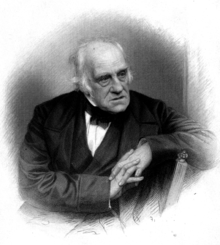- Henry Crabb Robinson
-
 engraving by William Hull after a photograph of Crabb Robinson
engraving by William Hull after a photograph of Crabb Robinson
Henry Crabb Robinson (1775–1867), diarist, was born in Bury St. Edmunds, England.
He was articled to an attorney in Colchester. Between 1800 and 1805 he studied at various places in Germany, and became acquainted with nearly all the great men of letters there, including Goethe, Schiller, Johann Gottfried Herder and Christoph Martin Wieland. Thereafter he became war correspondent to the Times in the Peninsular War. On his return to London he studied for the Bar, to which he was called in 1813, and became leader of the Eastern Circuit. Fifteen years later he retired, and by virtue of his great conversational powers and other qualities, became a leader in society. He died unmarried, aged 91, and his Diary, Reminiscences and Correspondence was published in 1869.[1]
Robinson's Diary contains important reminiscences of many of the central figures of the English romantic movement including Coleridge, Charles Lamb, William Blake, William Wordsworth, and others. Although the diaries contain no particularly significant revelations they are important documents regarding the daily lives of London writers, artists, political figures and socialites. In his essay on Blake, Swinburne says, "Of all the records of these his latter years, the most valuable, perhaps, are those furnished by Mr. Crabb Robinson, whose cautious and vivid transcription of Blake's actual speech is worth more than much vague remark, or than any commentary now possible to give."[2]
In 1829 Robinson was made a fellow of the Society of Antiquaries (F.S.A.), and contributed a paper to Archæologia entitled "The Etymology of the Mass".[3] He was buried in a vault in Highgate Cemetery alongside his friend Edwin Wilkins Field.[4] His diaries were bequeathed to Dr Williams's Library, because Robinson had been a member of the Essex Street Chapel, the first avowedly Unitarian congregation in England.
In 1935 Edith Morley wrote a biography of Henry Crabb Robinson which was published by J.M. Dent & Sons.
A bust of Crabb Robinson was made, and a portrait by Edward Armitage.[3]
References
- ^ Cousin 1910, p. 319.
- ^ Symons, Arthur (1907). "Appendix: Extracts from the Diary, Letters, and Reminiscences of Henry Crabb Robinson". William Blake. New York: E. P. Dutton and Company. pp. 331–335. http://en.wikisource.org/wiki/William_Blake_(Symons)/Extracts_from_the_Diary,_Letters,_and_Reminiscences_of_Henry_Crabb_Robinson.
- ^ a b
 Rae, William Fraser (1897). "Robinson, Henry Crabb". In Sidney Lee. Dictionary of National Biography. 49. London: Smith, Elder & Co. "sources: [Diary, Reminiscences, and Correspondence of Henry Crabb Robinson, by Dr. Thomas Sadler; Letters of Charies Lamb, ed. Ainger.]"
Rae, William Fraser (1897). "Robinson, Henry Crabb". In Sidney Lee. Dictionary of National Biography. 49. London: Smith, Elder & Co. "sources: [Diary, Reminiscences, and Correspondence of Henry Crabb Robinson, by Dr. Thomas Sadler; Letters of Charies Lamb, ed. Ainger.]" - ^
 Rigg, James McMullen (1897). "Rolt, Sir John". In Sidney Lee. Dictionary of National Biography. 49. London: Smith, Elder & Co. pp. 173,174.
Rigg, James McMullen (1897). "Rolt, Sir John". In Sidney Lee. Dictionary of National Biography. 49. London: Smith, Elder & Co. pp. 173,174.
- Attribution
This article incorporates text from a publication now in the public domainfrom the entry "Robinson, Henry Crabb" in: Cousin, John William (1910). A Short Biographical Dictionary of English Literature. London, J. M. Dent & Sons; New York, E. P. Dutton.
Further reading
- Diana Behler: Henry Crabb Robinson as a Mediator of Lessing and Herder to England. In: Lessing Yearbook 7 (1975), p. 105-126.
- Diana Behler: Henry Crabb Robinson: A British Acquaintance of Wieland and his Advocate in England. In: Christoph Martin Wieland. Nordamerikanische Forschungsbeitrage zur 250. Wiederkehr seines Geburtstages 1983. Ed. by Hansjörg Schelle. Tübingen 1984, p. 539-571.
- Diana Behler: Henry Crabb Robinson and Weimar. In: A Reassessment of Weimar Classicism. Ed. by Gerhart Hoffmeister. Lewiston (NY) 1996, p. 157-180.
- Jean-Marie Carré: Madame de Staël et Henry Crabb Robinson d’après des documents inédits. In: Revue d’histoire littéraire de la France XIX (1912), p. 539-546.
- D[avid] G[lass] Larg: Mme de Staël et Henry Crabb Robinson: Fiction et Vérité. In: Revue de littérature comparée 8 (1928), p. 654-671.
- Hertha Marquardt: Henry Crabb Robinson und seine deutschen Freunde. Brücke zwischen England und Deutschland im Zeitalter der Romantik. Nach Briefen, Tagebüchern und anderen Aufzeichnungen unter Mithilfe v. Kurt Schreinert. 2 Vols. Göttingen 1964.
- Stefanie Stockhorst: Gelehrte Geselligkeit und europäischer Kulturtransfer. Zur Deutung des produktiven Zu-sammentreffens von Henry Crabb Robinson und Mme. de Staël in Weimar. In: Jörg Drews/Gabi Pahnke (eds.): „Weimar ist ja unser Athen.“ Mit Seume in Weimar. Vorträge des Colloquiums zu Johann Gottfried Seume in Oßmannstedt 2007. Bielefeld 2010, p. 119–140.
- Stefanie Stockhorst: Was leistet ein ‚cultural turn‘ in der komparatistischen Imagologie? Henry Crabb Robinson als Vermittler deutscher Dichter- und Gelehrtenkultur nach England. In: arcadia 40.2 (2005), p. 354-374.
- Stefanie Stockhorst: Henry Crabb Robinsons doppeltes Deutschlandbild. In: Weimarer Beiträge 51 (2005), p. 254-269.
- James Vigus: Zwischen Kantianismus und Schellingianismus: Henry Crabb Robinsons Privatvorlesungen über Philosophie für Madame de Staël 1804 in Weimar. In: Germaine de Staël und ihr erstes deutsches Publikum. Literaturpolitik und Kulturtransfer um 1800. Ed. by Gerhard R. Kaiser and Olaf Müller. Heidelberg 2008, p. 357-393.
Categories:- 1775 births
- 1867 deaths
- English diarists
- English barristers
- People from Bury St Edmunds
- Fellows of the Society of Antiquaries of London
- British war correspondents
- English Unitarians
Wikimedia Foundation. 2010.
